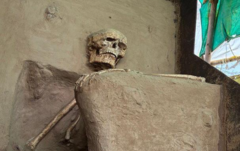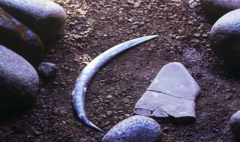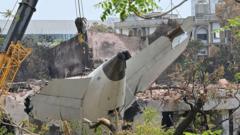The ancient skeleton, discovered in Vadnagar, India, six years ago, continues to remain without a permanent home in a museum due to complications among authorities.
Left in Limbo: Ancient Skeleton Waits for Home in India

Left in Limbo: Ancient Skeleton Waits for Home in India
Despite its historical significance, a 1,000-year-old skeleton unearthed in Gujarat remains unprotected and unexhibited due to bureaucratic delay.
The skeleton, estimated to be 1,000 years old, was found buried in a cross-legged position in Vadnagar, Gujarat, by archaeologist Abhijit Ambekar in 2019. Its discovery has significant implications for understanding early Indian society, especially the Solanki period during which it is believed to have existed. Unfortunately, despite the importance of this find, the skeleton still sits in a temporary shelter, subjected to the elements and without proper security due to bureaucratic disputes over its ownership.
Ambekar, leading the Archaeology Survey of India (ASI) in Mumbai, describes the skeleton as a valuable asset in uncovering the lifestyle and practices of ancient Indians. The local authorities, including the Gujarat Directorate of Archaeology and Museums, claim the skeleton remains under ASI control due to procedural issues during its transfer. Meanwhile, the ASI resumes this claim as they work toward the skeleton’s relocation, as confirmed by state officials.
While the skeleton awaits a permanent resting place, it has become something of a local curiosity. Residents express disappointment that a significant historical artifact is left exposed, especially with a newly constructed museum nearby that features over 5,000 artifacts but lacks the actual skeleton. Critics of the situation argue that this neglect contradicts efforts to celebrate Vadnagar's rich history, which dates back over 2,500 years.
In addition to the skeleton, ongoing archaeological digs have unearthed remnants of ancient settlements and monasteries, reinforcing the area's importance. Ambekar believes that further studies of the skeleton could unveil insights into ancient Hindu burial practices known as samadhi burials.
As the wait continues, locals call for more efficiency in resolving the bureaucratic hurdles, hoping to finally see this remarkable discovery housed in a proper museum that showcases its historical relevance and protects it from environmental damage.
Ambekar, leading the Archaeology Survey of India (ASI) in Mumbai, describes the skeleton as a valuable asset in uncovering the lifestyle and practices of ancient Indians. The local authorities, including the Gujarat Directorate of Archaeology and Museums, claim the skeleton remains under ASI control due to procedural issues during its transfer. Meanwhile, the ASI resumes this claim as they work toward the skeleton’s relocation, as confirmed by state officials.
While the skeleton awaits a permanent resting place, it has become something of a local curiosity. Residents express disappointment that a significant historical artifact is left exposed, especially with a newly constructed museum nearby that features over 5,000 artifacts but lacks the actual skeleton. Critics of the situation argue that this neglect contradicts efforts to celebrate Vadnagar's rich history, which dates back over 2,500 years.
In addition to the skeleton, ongoing archaeological digs have unearthed remnants of ancient settlements and monasteries, reinforcing the area's importance. Ambekar believes that further studies of the skeleton could unveil insights into ancient Hindu burial practices known as samadhi burials.
As the wait continues, locals call for more efficiency in resolving the bureaucratic hurdles, hoping to finally see this remarkable discovery housed in a proper museum that showcases its historical relevance and protects it from environmental damage.





















